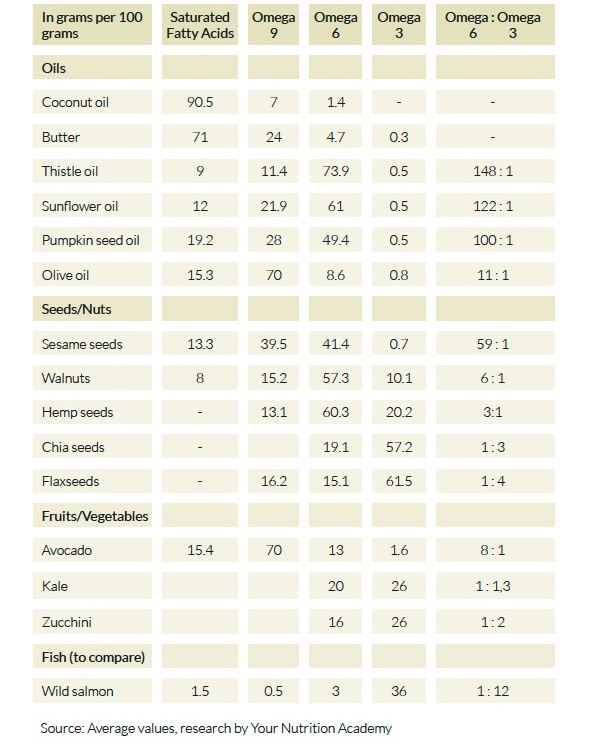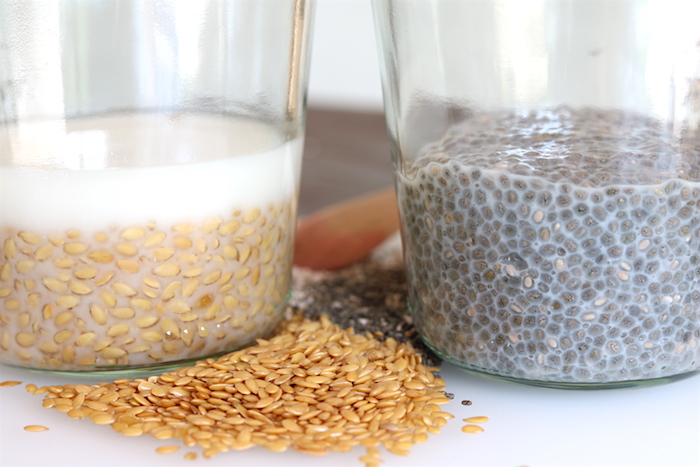In recent years, the discussion about the correct omega-6 to omega-3 ratio has become increasingly important, as it has been recognized as crucial for the health of our hearts, brains and overall metabolism.
Despite their importance, there’s often confusion about how the correct ratio of these fatty acids can still be achieved with our current diets. Many people unknowingly consume too much omega-6 and too little omega-3, which can lead to health problems. However, a balanced omega-6 to omega-3 ratio is essential to reduce inflammation in the body and minimize the risk of chronic diseases.
In this article, we’ll address the most important questions surrounding the omega-3 debate:
- Why is the ratio between omega-6 and omega-3 so important?
- What are the health effects of an unbalanced ratio?
- Do we need to supplement omega-3 fatty acids or is it possible to achieve the correct omega-6 to omega-3 ratio through a targeted diet?
What are Omega-3 and Omega-6 Fatty Acids?
Omega-3 and omega-6 fatty acids are polyunsaturated fatty acids that the body cannot produce by itself and therefore must be consumed with daily food. Ideally, the aim is to achieve a ratio close to 1:1, as was the case with our early ancestors, in order to optimally support health. In modern diets, however, the ratio is often much higher, which can lead to health problems. The German Nutrition Society recommends that a maximum ratio of 5:1 should be maintained.
However, most people consume on average 15-20 times more omega-6 than omega-3 fatty acids, as omega-6 fatty acids are overrepresented and omega-3 underrepresented in our daily diet.
Both fatty acids are precursors of messenger substances in the body that are responsible for regulating blood pressure or inflammatory reactions, among other things.
Omega-6 fatty acids
Omega-6 fatty acids include arachidonic acid and linoleic acid.
Arachidonic acid is found in animal foods. Too much arachidonic acid promotes blood clotting, increases the tendency of heart attacks, arteriosclerosis, strokes, cancer and inflammatory processes, including in the brain. Permanent inflammatory conditions in the brain are considered to be a contributing cause of dementia, Alzheimer’s and depression.
Linoleic acid is found in plant-based foods, for example in sunflower and pumpkin seeds or in a more concentrated form in their oils. It’s an important component of our skin and valuable for the synthesis of other unsaturated fatty acids. Linoleic acid is converted into the anti-inflammatory gamma-linolenic acid and, in a further step, the inflammation-promoting arachidonic acid (containing approximately 5-10% of the original linoleic acid).
Note:
Sunflower oil has an omega-6 to omega-3 ratio of 122:1. It’s found in most ready-made products such as plant milk, dressings or vegan dips and spreads and contributes significantly to the omega-6 to omega-3 fatty acid ratio becoming unbalanced.
Omega-3 fatty acids
Omega-3 fatty acids include alpha-linolenic acid (ALA), docosahexaenoic acid (DHA) and eicosapentaenoic acid (EPA).
ALA is a plant-based omega-3 fatty acid that is mainly found in flax seeds, chia seeds, walnuts and leafy green vegetables. In the body, ALA can be partially converted into the long-chain omega-3 fatty acids EPA and DHA, but only to a limited extent, about 5-10%.
EPA is found primarily in marine fish such as salmon, mackerel and sardines. This long-chain omega-3 fatty acid plays a crucial role in regulating inflammatory processes in the body and supports the health of the heart and blood vessels.
DHA is also present in fatty fish such as salmon, tuna and herring. It’s particularly important for the development and health of the brain, eyes and nervous system.
Formation of DHA and EPA
For the formation of DHA and EPA from omega-3 fatty acids, a balanced ratio of omega-6 to omega-3 fatty acids in the diet is crucial.
Common enzymes:
Omega-6 and omega-3 fatty acids use the same enzymes (delta-6 desaturase and delta-5 desaturase) to convert them into their biologically active forms.
Competition for enzymes:
In an omega-6-rich diet, omega-6 fatty acids compete with omega-3 fatty acids for these enzymes. This can hinder the conversion of omega-3 fatty acids into DHA and EPA.
Conversion rate:
Only about 5-10% of ALA (omega-3 fatty acid) is converted to EPA and less than 5% to DHA. A high omega-6 content can further reduce this low conversion rate.
A balanced ratio helps ensure that the enzymes needed to convert omega-3 fatty acids (such as ALA) into the biologically active forms EPA and DHA are not blocked by an excess of omega-6 fatty acids.
Would you like to deepen your knowledge of healthy plant-based nutrition in our distance training program to become a Holistic Health and Nutrition Coach? Then request our curriculum today!
Health Risks of an Unbalanced Omega-6 to Omega-3 Ratio
An unbalanced ratio of omega-6 to omega-3 fatty acids can have significant health effects. These two types of fatty acids are essential for the production of messenger substances in the body that control numerous physiological functions such as blood pressure regulation and inflammatory reactions.
While the messenger substances from omega-6 fatty acids promote inflammation, those from omega-3 fatty acids have an anti-inflammatory effect.
An excess of omega-6 fatty acids can therefore lead to an increased tendency towards inflammation, which increases the risk of various diseases such as heart attack, arteriosclerosis, stroke, cancer and other inflammation-related conditions.
👉 Studies have shown that a balanced ratio of omega-6 to omega-3 fatty acids can significantly reduce inflammation, improve blood flow properties and promote blood circulation (1).
👉 Omega-3 fatty acids are also good for bones and joints (2). They promote the formation of bone-building cells, improve joint mobility, decrease inflammatory joint pain such as rheumatism and arthritis, and the skin becomes more beautiful.
👉 An imbalance in favor of omega-6 fatty acids can also increase inflammatory processes in the brain, which are discussed as possible causes of dementia, Alzheimer’s and depression (3).
It’s therefore essential to maintain the balance of these fatty acids in order to promote both physical and mental health.
Omega-3-Rich Foods
In order to be able to make our everyday diet “fatty acid conscious,” it’s important to know about omega-6-rich and omega-3-rich foods. The following overview shows the fatty acid composition and the omega-6 to omega-3 ratio of various foods.

Based on this table, we can gain the following insights to optimize the omega-6 to omega-3 ratio in our diet:
Fats that are rich in saturated fatty acids have a neutral omega-6 to omega-3 ratio
- Saturated fatty acids are found in animal products such as butter, cheese, meat and also in some plant sources such as coconut oil and palm oil.
- These fats don’t contain omega-6 or omega-3 fatty acids in significant amounts, which means that their consumption does not significantly affect the omega-6 to omega-3 ratio.
Most vegetable oils are very rich in omega-6 fatty acids
- Sunflower oil, safflower oil or pumpkin seed oil should be avoided with regard to the omega-6 fatty acid ratio.
Fruits and vegetables have a largely neutral omega-6 to omega-3 ratio
- Fruits and vegetables generally contain very low amounts of fat.
- If they contain fat, the amounts of omega-6 and omega-3 fatty acids are often balanced or so low that they don’t significantly affect the ratio in the diet.
Our richest plant sources of omega-3 are flaxseeds, chia seeds, hemp seeds and seaweed
- Flaxseeds and chia seeds are our best plant sources of omega-3 fatty acids. Hemp seeds also support a balanced ratio with an omega-6 and omega-3 fatty acid ratio of 3:1.
- Seaweed is one of the few plant sources of EPA and DHA. Although they provide much lower amounts of omega-3 than hemp seeds or flaxseeds, they’re particularly valuable.
Close up:
Particularly fatty fish such as salmon, mackerel and sardines are excellent sources of EPA and DHA. They have a very favorable ratio of omega-6 to omega-3, often around 1:9 to 1:25, which means they are rich in omega-3 fatty acids and contain only small amounts of omega-6.
Due to overfishing, the proliferation of microplastics and heavy metals, we recommend rethinking the consumption of fatty fish or paying attention to sustainable sources.
Recommendations for Healthy Fat Intake
To avoid mistakes in the consumption of fats and to promote a healthy diet, we make the following recommendations:
1. Prioritize fresh, unprocessed foods
Make fresh fruits and vegetables your basic ingredients, as they are rich in nutrients and have a largely neutral omega-6 to omega-3 ratio.
2. Add natural omega-3 sources
Complete your dishes with natural omega-3 sources and always give preference to fat sources such as flaxseed, hemp seeds and chia seeds – for example in the form of dips or dressings.
3. Selection of suitable oils
For cooking, we should choose oils with a high content of saturated fatty acids such as coconut oil and ghee (not vegan), as these are heat-resistant, do not oxidize and do not form trans fats even at high temperatures.
Flaxseed oil, which has a favorable ratio of omega-6 to omega-3 fatty acids of 1:4, and olive oil, which is relatively low in omega-6, are particularly suitable for salads and cold dishes. Olive oil is also rich in omega-9 fatty acids and contains valuable secondary plant substances that also have a health-promoting effect.
4. Avoiding omega-6-containing oils
Omega-6-containing oils such as sunflower, safflower or pumpkin seed oil should be avoided or at least used sparingly as excessive consumption can cause an imbalance in the ratio of omega-6 to omega-3 fatty acids.
5. Temporary supplementation
Alternatively, high-quality algae oil supplements can serve as an omega-3 source as they are purified and tested for contaminants. Algae oil is an excellent option especially for vegetarians and vegans as it provides DHA and EPA.
Omega-3 Rich Recipes
Chia Seed Meets Flaxseed Pudding
A delicious omega-3 rich breakfast or dessert is our “chia seed meets flaxseed pudding.” This combination combines the best properties of chia seeds and flaxseed in a layered treat while providing our bodies with valuable nutrients.
Mozzarella prepared with hemp seeds
This healthy and innovative version of classic mozzarella uses the swelling properties of psyllium husks together with omega-3-rich hemp seeds.
Hemp seed dressing
The omega-3-rich hemp seed dressing turns your salad meal into a dish with a balanced omega-3 to omega-6 fatty acid ratio.
Conclusion: Do We Need to Supplement Omega-3 Fatty Acids?
Many vegetable oils, nuts, seeds and ready-made products such as plant-based milk or vegan spreads are rich in omega-6 fatty acids. That’s why it’s important to pay close attention to fat supply in a purely plant-based diet. Using the information from this article, you’re better able to choose your fat sources specifically in order to achieve a balanced omega-6 to omega-3 ratio in the long term.
👉 It’s therefore possible to achieve a balanced fatty acid ratio by consciously choosing the right fat sources. However, it can be challenging in everyday life to maintain the perfect fatty acid ratio every day. Lack of time and the complexity of meal planning can make it difficult to always ensure an optimal supply of omega-3 fatty acids. Therefore, in certain situations, it may be useful to temporarily supplement with algae oil. Algae oil offers an excellent source of the important omega-3 fatty acids EPA and DHA.
It should be noted, however, that supplementing with algae oil can be insidious. This could give the false impression that the consumption of low-quality fats, such as omega-6-rich sunflower oil or trans fats, can be compensated. It remains important to keep an eye on the overall fat quality in the diet and not rely on supplements alone.
Would you like to join our unique program, based on nutritional sciences and practice-oriented training for gaining a high level of health?
We’re more than happy to inform you about all that our training program offers on our website!









0 Comments